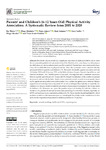Mostrar o rexistro simple do ítem
Parents’ and Children’s (6–12 Years Old) Physical Activity Association: A Systematic Review from 2001 to 2020
| dc.contributor.author | Matos, Rui | |
| dc.contributor.author | Monteiro, D. | |
| dc.contributor.author | Amaro, Nuno | |
| dc.contributor.author | Antunes, Raul | |
| dc.contributor.author | Coelho, Luís | |
| dc.contributor.author | Mendes, Diogo | |
| dc.contributor.author | Arufe-Giráldez, Víctor | |
| dc.date.accessioned | 2022-03-14T12:58:28Z | |
| dc.date.available | 2022-03-14T12:58:28Z | |
| dc.date.issued | 2021 | |
| dc.identifier.citation | Matos, R.; Monteiro, D.; Amaro, N.; Antunes, R.; Coelho, L.; Mendes, D.; Arufe-Giráldez, V. Parents’ and Children’s (6–12 Years Old) Physical Activity Association: A Systematic Review from 2001 to 2020. Int. J. Environ. Res. Public Health 2021, 18, 12651. https://doi.org/10.3390/ ijerph182312651 | es_ES |
| dc.identifier.uri | http://hdl.handle.net/2183/29982 | |
| dc.description | This article belongs to the Special Issue Physical Activity in Childhood and Adolescence | es_ES |
| dc.description.abstract | [Abstract] Worldwide, studies reveal that a significant proportion of adults and children do not meet the recommended guidelines for physical activity (PA). Therefore, it is crucial that proxy determinants for child physical activity enhancement could be identified. Parents have been considered to have a key role in child adherence to physical activity. Thus, this systematic review aimed to identify association between parents’ and children’s PA. The search of scientific papers was conducted from 31 October 2020 until 31 January 2021, on the Web of Science, Scopus, Psycinfo, SportDiscus, and Pubmed databases. The PRISMA protocol was used. Findings indicate a consistent association between parents’ and children’s (6–12 years old) PA. Despite the imbalance of the number of assessed fathers and mothers with the latter clearly overrepresented, a trend towards the same gender dyads on PA significant and positive association (father/son, mother/daughter) was evidenced. Results support the relevant importance of parents’ PA as role modeling (either explicitly or implicitly) for children’s PA. Besides, results revealed the importance of promoting PA in family for the enhancement of children’s PA. Moreover, and given the positive impact of exerting PA with the children on children’s PA, parents should spend more time practicing PA with their children, especially on MVPA and meeting the recommended guidelines for PA. Future studies should highlight the role of mediator variables on this interaction process, extending the knowledge on the contribution of other factors to the requested enhancement of children adherence to PA practice. | es_ES |
| dc.description.sponsorship | This research, including APC, were funded by FCT-Fundação para a Ciência e a Tecnologia, I.P., grant number UIDB/04748/2020 | es_ES |
| dc.description.sponsorship | Portugal. Fundação para a Ciência e a Tecnologia; UIDB/04748/2020 | es_ES |
| dc.language.iso | eng | es_ES |
| dc.relation.uri | https://doi.org/10.3390/ijerph182312651 | es_ES |
| dc.rights | Atribución 4.0 Internacional | es_ES |
| dc.rights.uri | http://creativecommons.org/licenses/by/4.0/ | * |
| dc.subject | Parental modeling | es_ES |
| dc.subject | Childhood | es_ES |
| dc.subject | MVPA | es_ES |
| dc.subject | Co-participation | es_ES |
| dc.title | Parents’ and Children’s (6–12 Years Old) Physical Activity Association: A Systematic Review from 2001 to 2020 | es_ES |
| dc.type | info:eu-repo/semantics/article | es_ES |
| dc.rights.access | info:eu-repo/semantics/openAccess | es_ES |
| UDC.journalTitle | International Journal of Environmental Research and Public Health | es_ES |
| UDC.volume | 18 | es_ES |
| UDC.issue | 23 | es_ES |
| UDC.startPage | 12651 | es_ES |
| dc.identifier.doi | 10.3390/ijerph182312651 |
Ficheiros no ítem
Este ítem aparece na(s) seguinte(s) colección(s)
-
UI- UNIDEF - Artigos [35]






